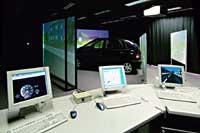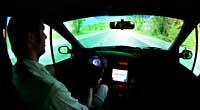Wake up, move it, you're driving!
2005/03/13 Galarraga Aiestaran, Ana - Elhuyar Zientzia

The system has already been invented. More than for those who come from the cider, it is for those who have been driving for a long time, but in reality it serves everyone. It is a matter of warning the driver of the danger of falling asleep just to begin sleep. It should be taken into account that the work and the high number of driving hours make the risk of accidents higher and it is estimated that 1% of the accidents that occur on the roads are due to sleep.
To avoid this, six industrial engineering students from the Public University of Navarre have invented a special device, more secure than so far. In fact, it detects sleep before other systems, just before the first symptoms appear.
The systems invented so far are based on the detection of obvious sleep symptoms. For example, there are cameras that analyze the movement of the eyes or the head. When the eyes shoot often, the driver loses attention or tilts the head, the system is activated and the warning signs are set in motion to the driver.
Based on brain waves

The system presented by the students of the Public University of Navarra detects before the rest that the driver is the dream. Before starting to shoot your eyes often, or starting to bend your head from side to side, the newly invented device knows that the driver is the dream. How have you got it? Thus analyzing the brain waves of the driver. It analyzes the waves one by one and, if abnormal behavior is detected, means the driver sleeps. Therefore, the device warns before the accident.
The device is a special hat connected to a PDA or small pocket computer. The beret has sensors inside, so that they are pressed against the skull where the sensors need. Magnetic sensors collect the waves produced by the brain and a light tool that is found in the back of the hat collects the information. Then all the information is sent to the PDA. The connection between this small device and the PDA is made by radiofrequency, since the cable connection can be dangerous in case of accident.
The PDA analyzes the information that arrives and checks if the wave is normal or, conversely, the driver sleeps. In this second case, other devices should be launched. Objective: to awaken the driver, warn of the situation or remove the vehicle from the road. But all this has not been developed.
In collaboration with neurologists

The students of industrial engineering have counted for the realization of the project with the collaboration of neurologists of the Clínica Universitaria. They guided the students to study brain waves. In this work they have seen that there are five types of waves, according to their amplitude and frequency. When a person sleeps, the amplitude of these brain waves increases and the frequency decreases. In the transition between alpha and theta waves, the person is dorsal. And at that time the device would be launched.
This device that alerts the driver of the existence of drowsiness has a cost of approximately 4.500 euros, so currently it is still very expensive. For example, for a car driver it can be excessive, but not for a professional driver if we compare it to the value of a truck or bus. Therefore, the device is especially suitable for drivers of this type of vehicle.
XVIII Meeting of Inventors on Automotive in Barcelona. Presentation of the device in technical days. The day of this year has been dedicated to safety in the car.
Continuous research

In the design of vehicles and materials is also being investigated continuously with the aim of increasing safety. They try it on the one hand, focusing on ways to avoid accidents and on the other, on passenger protection systems in case of accident. The first are active systems and the others are passive.
Among the active safety systems are the chassis design, brakes, suspension, steering, tyres and anti-flip systems. Among the liabilities are, among others, the airbag, part of the chassis and the body, the safety belt and the crystals. In all these elements progress is being made and, although they are sometimes given a touch of marketing when they present their advances, these are beneficial. Nor is it surprising, since the life of drivers and passengers is above marketing and sales.
Published in 7K.




